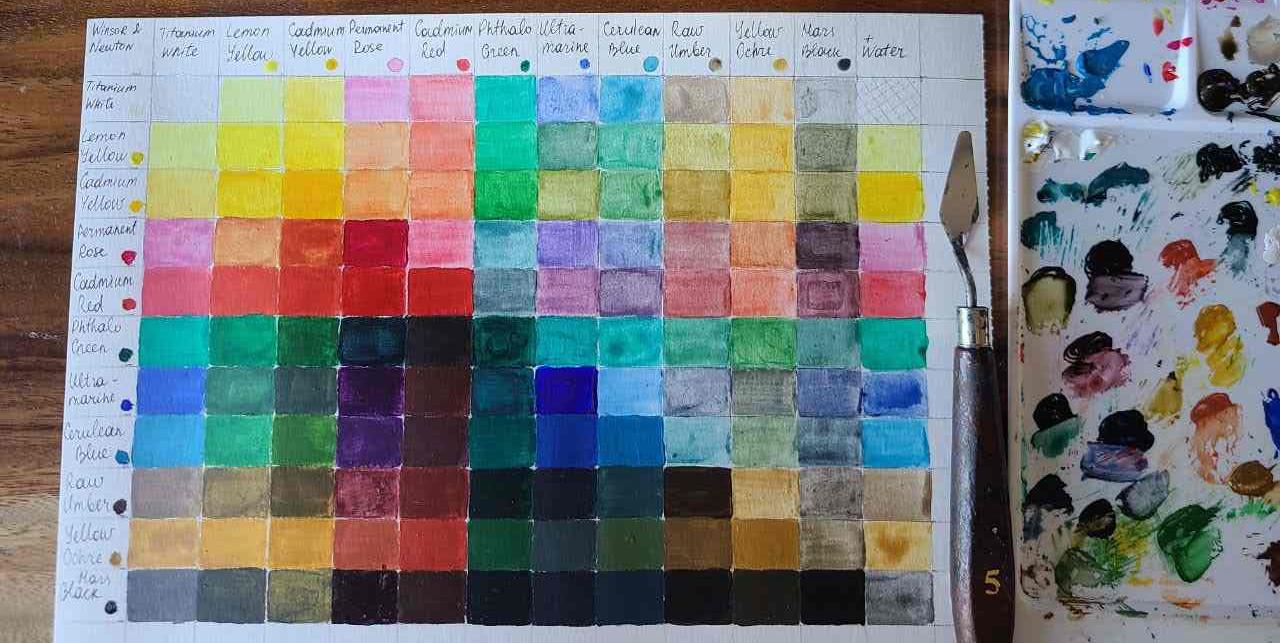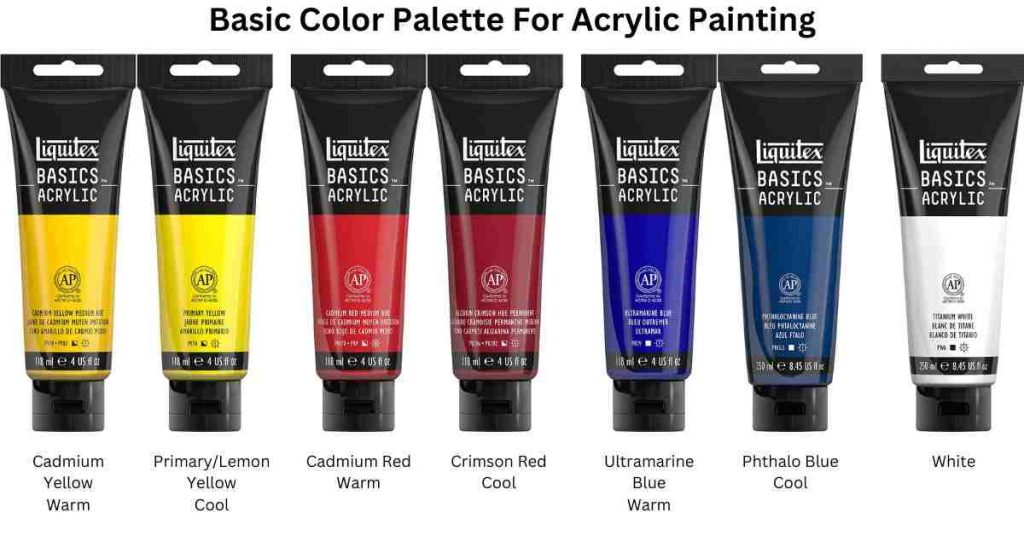Last Updated on March 21, 2024 by Masha Eretnova
Painting with acrylic paints is fun until you run out of colors. But don’t worry too much; creating your own paint might sound intimidating, but if you know the basics, the question “how to mix acrylic paint” could be fun.
You can mix acrylic paint using any of these methods: mixing acrylic paints on a palette, scumbling or glazing, optical mixing, or by using the wet-to-wet technique.
Sit back and be with us as we dive into the colors, learn things beyond the basics, and learn how to mix acrylic paint close to perfection.
Table of Contents
Can I mix my own paint?
Yes, you can mix your own paint. It would help you save money, maximize time, and be more creative.
Mixing your own paint would be better if you knew the basics about colors and what colors to blend with one another. If you are a beginner, it will help you expand your knowledge about colors.
Color wheel and color theory for beginners
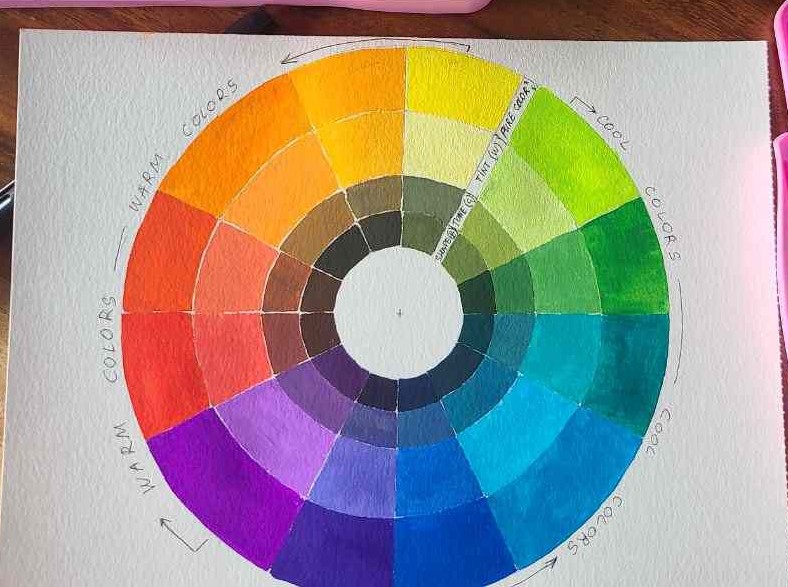
Getting familiar with the color wheel and color theory is the fundamentals of mixing colors.
The color wheel is a circular chart divided into 12 colors with an arrangement showing their relationship. These 12 colors are divided into 3 groups, primary, secondary, and tertiary.
3 Primary Colors
Primary colors are the base or foundation of every color wheel color. Pure primary colors cannot be re-created by mixing colors. Red, yellow, and blue are known as the primary colors; they are placed opposite each other in color, forming a triangular shape.
Warm and Cool colors
So there are only 3 primary colors but your basic palette setup should include a warm and a cool shade of each primary color to help you mix new colors better.
Warm colors are those that look like they are going towards light on the color wheel, so from red to yellow. Ex., classic Cadmium Red is a warm color. On my color wheel they are on the left side.
Cool colors are somewhat going into the dark light, from blue green to violet. So if you see a color and it feels blueish, dark, in a shadow it is probably a cool color. Ex., Crimson is a cool color. On my color wheel chart they are on the right side.
Green, green blue, violet and red violet (purple) can be both warm and cool.
For mixing you normally will take both warm or cool to avoid mud.
Secondary Colors
The secondary colors are green, violet, and orange. Secondary colors are produced by combining primary colors and they are located in between primary colors on the color wheel.
- Red and blue make violet.
- Red and yellow make orange.
- Blue and yellow make green.
Secondary colors are also placed in a triangular pattern like the primary colors.
Tertiary Colors
Tertiary colors fill the gap in the color wheel; they are created by combining primary and secondary colors.
- Red and orange make red-orange.
- Red and violet make red-violet.
- Blue and violet make blue-violet.
- Blue and green make blue-green.
- Yellow and orange make yellow-orange.
- Yellow and green make yellow-green.
Triadic Colors
Triadic colors are 3 colors spaced equally in the color wheel in a triangular pattern. There are 4 triadic colors in the color wheel, these are:
- Red-Blue-Yellow
- Violet-Green-Orange
- Blue-violet-Yellow-green-Red-orange
- Blue-green-Red-violet-Yellow-orange
Complementary Colors
Complementary colors are opposite colors on the wheel, such as yellow and violet. The contrast between complementary colors is strong in that they stand out when placed beside each other.
Complementary colors:
- red and green
- yellow and purple
- orange and blue, etc
When complementary colors are mixed, they create darker neutral colors like gray, black, or brown.
Complementary colors can also be used to mute (dull) one another, to mute purple, or add a tiny bit of yellow of the same warmth.
Complementary colors are great to know if you are looking for perfect combinations for pouring, art or home interiors.
Why they called neutral colors? Because our eyes perceive colors through light. If you look at the purple color for too long, your brain will read that your eyes are tired and make a signal. When you turn your head away you will see yellow – complementary or neutralizing color – to help your eyes come back to their neutral state.
Why there is no black on the wheel or in the palettes artists use? Black is the total absence of light ot color, pros don’t buy black color as they can mix it or create shadows and accents without it by using darker shades of colors.
Analogous Colors
Analogous colors are colors adjacent to each other in the color wheel. Analogous colors like violet, blue-violet, and blue are harmonious with the eyes.
Additive Colors RGB Model
Additive colors are red, green, and blue. It is also known as the RGB model. Additive colors start with black (then add red, green, and blue light to produce a visible spectrum (secondary colors) and end with white if mixed together equally.
RGB is often used in digital presentations.
Subtractive Color CMYK Model
Subtractive colors are cyan, magenta, yellow, and black. It is also known as the CMYK model, the opposite of the RGB model. It starts with white and ends with black if mixed together equally.
CMYK is often used in print settings.
Color Theory Glossary
Here are other terms you will encounter as we go through color mixing:
- Hue: Hue is a pure color without shade or tint, ex. Red
- Shade: Shade refers to lighter or darker variations of colors. (usually, color mixed with black)
- Tint: Tint is a color that has white in it. It makes the hue lighter.
- Tone: Tone in color refers to its lightness or darkness. (color mixed with grey)
- Value: the lightness or darkness of a color (white changes the value of the color)
- Chroma: the purity or intensity of a color
- Local color: the overall color of an object that we perceive. Ex., banana – yellow is its local color.
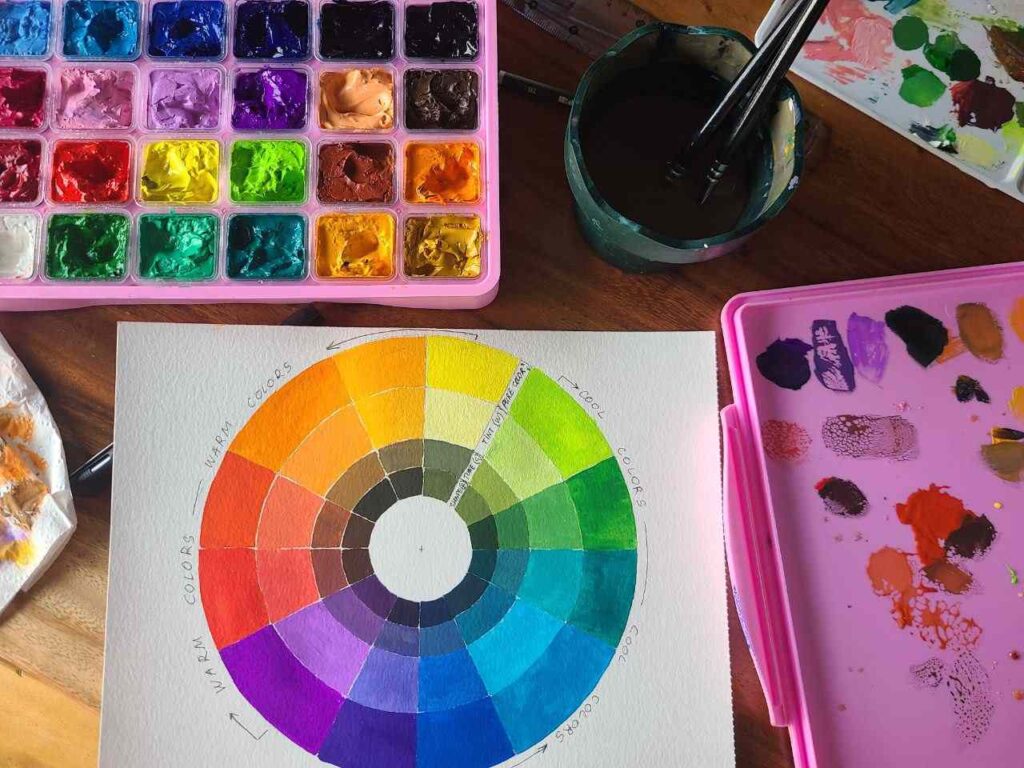
As you can see on my color wheel I have pure color – outer rim, second, comes tint, then tone and shade for each color. I also mark which parts of the wheel are warm or cool colors.
This is how we end up with our palette of 3 primary colors in warm and cool settings. This actually works for ANY mediums – acrylic, gouache, oil, watercolor – doesn’t matter.
- warm red, ex. Cadmium Red
- cool red, like Crimson Red
- warm yellow, like Cadmium Yellow
- cool yellow, like Lemon Yellow
- warm blue, like Ultramarine blue
- cool blue, like Phthalo Blue or Prussian Blue. You will also find artists saying that Ultramarine blue is cool, while Phthalo is warm.
- white (Titanium white)
How to mix acrylic paint?
Before diving into the actual mixing, let us learn the techniques of how we can mix acrylic paint.
Here are the techniques we can use in mixing acrylic paint:
Mixing paints on a palette
This is the most common method artists use. They mix the colors directly in a palette. I prefer using flat plastic or paper palettes and a palette knife.
I prefer a palette knife over a brush as it is easier to clean in between colors (you just use a paper towel or regular towel, while with brush you constantly need water and drying it, and it is also wastewater disposal question).
Scumbling or glazing
This method is used when combining (layering) a thin layer of color over your base color when the base color is slightly visible.
Optical mixing
Optical mixing is mixing two colors using different strokes on one canvas/paper creating a gradient, this is closer to blending than proper mixing.
Wet-on-wet technique
This method is used when you directly mix the paint on the paint while it’s still wet. It can be tricky when using acrylic paint because it dries fast, but it is possible.
Learn more Acrylic Painting Techniques For Beginners to Paint like a Pro
Tips and tricks Worth Trying out when mixing Acrylic Paints
Now that you know the color wheel, color theory basics, and techniques in mixing acrylic paint, you can start your journey by trying these tips and tricks.
On a palette or paper and use them in your next project.
- Mix darker color into the lighted color.
- Use white paint to make your color more opaque and complex.
- When you squeezed some paint on palette to avoid contamination, just pull a bit of paint out with a brush each time you need this color. This way, all the rest paint will stay clean. Or I also do wipe my brush with a dry towel each time.
- Use a brown or darker shade of blue to darken your color. Avoid using black because it will make your color look muddy.
- Blend complementary colors to get black or lovely darker shades.
- Warm colors remind us of the sun or fire.
- Cool colors remind us of the sky or ocean.
- Wait until dry, acrylic tend to dry a bit darker and if will affect the final result.
- Don’t rely on photos too much. Even making swatches for color mixing articles I can confirm that on photos the different color nuances are not as visible as in real life.
There are 12 colors on color wheel and numerous shades we can possibly create.
Let’s start by learning the main 12 colors first and some extra tricks, for ex., how to mix silver or metallic colors.
How to mix blue color?
Blue is one of the primary colors, which means creating a “pure or natural blue,” which is out of the picture, but we can learn how to make blue colors or different tones of blue.
Blue is one of the most used colors, the only cool color in primary colors. Creating different tones of blue is great for making your arts and crafts more beautiful.
We will use ultramarine blue and cobalt blue acrylic paints as our base colors.
Related:
- What do Blue and Brown make? Testing 8 Shades of Blue & 6 Brown
- What Color does Orange and Blue make?
How to make blue lighter?
Blending ultramarine and white, cobalt blue and white will both create a shade of light blue. You can add cadmium orange to make a muted light blue.
- ultramarine blue + white = light blue
- ultramarine blue + white + cadmium orange= muted light blue
- cobalt blue + white = light blue
- cobalt blue + white + cadmium orange = muted light blue
When blue is blended with white, you’ll notice that:
- Ultramarine blue is a warm shade of blue which leans towards purple.
- Cobalt blue is a cool shade of blue which leans towards green.
How to make blue darker?
To make blue darker, we’ll use a darker shade as a base, ultramarine blue.
- Ultramarine blue + dioxazine purple
- Ultramarine blue + dioxazine purple + phthalo green
- Ultramarine blue + burnt umber
- Ultramarine blue + phthalo green + alizarin crimson
How to make turquoise colors?
To make a painting more realistic, the artist often used shades other than light and dark; for ocean, sea, and sky, let’s learn how to make turquoise colors using blue.
- Ultramarine blue + cadmium green + white
- Cobalt blue + cadmium green + white
- Ultramarine blue + veronese green + white
- Cobalt blue + veronese green + white
You can still lighten the mixture by gradually adding white until you achieve your desired color.
How to make the sky blue color?
To make sky blue using acrylic paint, you will need:
- Ultramarine Blue
- Titanium White
- Quinacridone Magenta
- Hansa Yellow Medium (or Cadmium Yellow)
Use
Ultramarine blue is more vivid and saturated than the color of the sky; to neutralize it add a bit of quinacridone magenta into your mixture.
If the mixture turns violet, add a bit of Hansa yellow medium to mute it.
Swatching your mixture after every stage will help you see their differences.
Add more white to lighten your sky blue color and ultramarine blue to darken it.
How to mix red color?
Red is a primary color; hence, creating one by blending other colors is out of the picture. Yet, to make red color you can mix magenta (darker shades) with yellow.
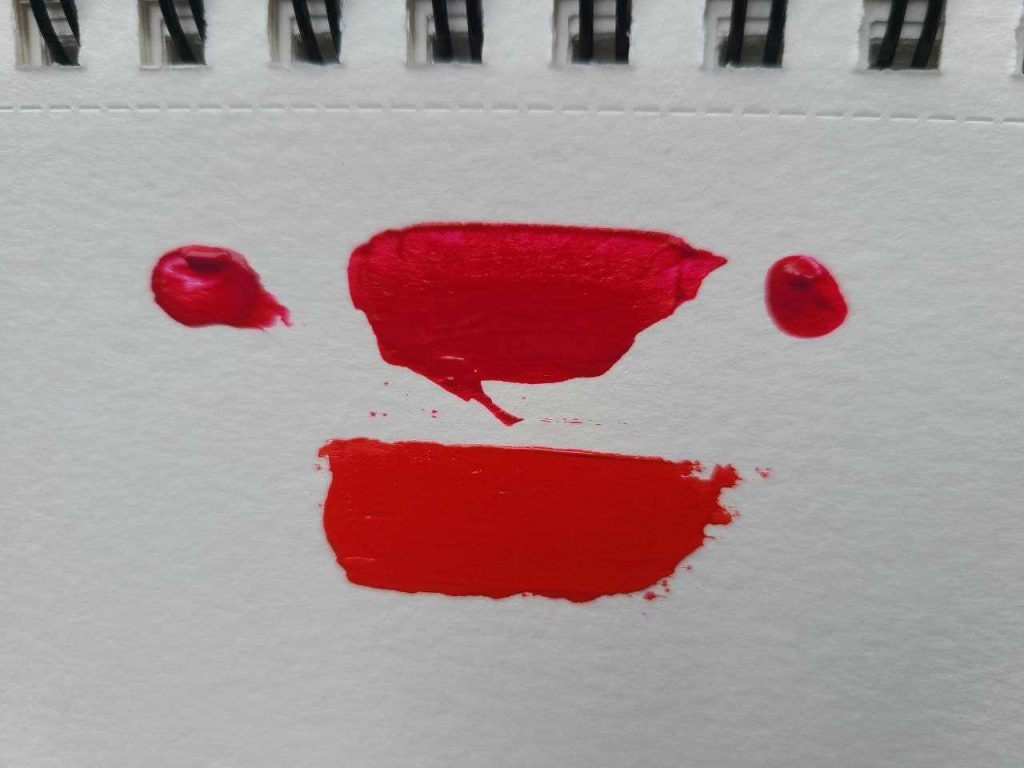
But of course, we can use the readily available shades of red and combine them with others to create different tints and shades.
Here are some shades of red we can use as a base:
- Alizarin crimson – a cooler shade of red
- Cadmium red – a warmer shade of red.
Read full article on How to Make Magenta? My 2 Personal Methods
How to make light red colors?
We can use white and cadmium lemon yellow to make a lighter red.
- Alizarin crimson + white
- Alizarin crimson + cadmium lemon yellow
- Cadmium red + white
- Cadmium red + cadmium lemon yellow
How to make dark red?
We can use brown black and rich black to make a darker red.
- To make a rich black, blend phthalo green with alizarin crimson.
- To make brown black, mix burnt umber and ultramarine blue.
Now that you have your brown black and rich black, let’s mix it up and create a darker shade of red.
- cadmium red + brown black (burnt umber + ultramarine blue)
- alizarin crimson + brown black (burnt umber + ultramarine blue)
- cadmium red + rich black (phthalo green + alizarin crimson)
- alizarin crimson + rich black (phthalo green + alizarin crimson)
What colors make red muted?
To mute a color, we must mix complementing colors; in this case, green complements red, so we will blend red with green.
- cadmium red + cadmium green
- alizarin crimson + cadmium green
- cadmium red + phthalo green
- alizarin crimson + phthalo green
The result will be a (muted) darker red; you can lighten it by blending the mixture with white until you achieve your desired shade.
- (cadmium red + cadmium green) + white
- (alizarin crimson + cadmium green) + white
- (cadmium red + phthalo green) + white
- (alizarin crimson + phthalo green) + white
How to mix the yellow color?
Yellow is the lightest color next to white and the brightest color on your palette. Like blue and red, yellow is a primary color; therefore, we can’t mix or blend shades to create a “natural” yellow.
However, we can use the shades of yellow readily available to create lighter, darker, or muted shades of yellow.
Here are some shades of yellow in the market:
What if we mix yellow with other colors? Check Mix of Yellow and Purple: What These 2 Colors Make? Surprising results
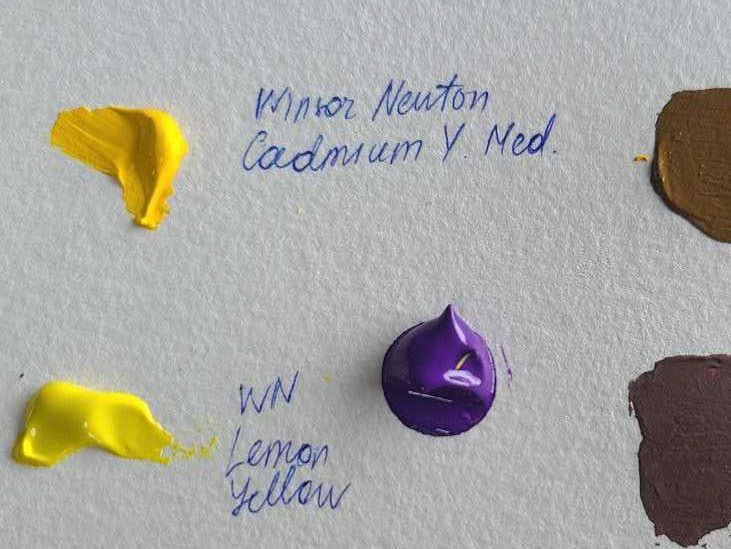
How to create a darker shade of yellow?
We can use rich black and brown black to make a darker shade of yellow.
Blend burnt umber and ultramarine blue to get a brown-black color and phthalo green and alizarin crimson to get rich black.
Avoid directly blending ultramarine blue into your yellow, as it becomes greener than darker yellow.
Mixing alizarin crimson directly into your yellow might look like a darker shade of orange than yellow.
Let’s see what the darker shades of yellow would look like.
- Cadmium yellow + (burnt umber + ultramarine blue) brown-black
- Yellow ochre + (burnt umber + ultramarine blue) brown-black
- Cadmium yellow + (phthalo green + alizarin crimson) rich black
- Yellow ochre + (phthalo green + alizarin crimson) rich black
How to make a lighter shade of yellow?
Although yellow can be the lightest color in your palette next to white, there would be instances when making it lighter would be more beautiful.
Let’s try making a lighter shade of yellow by blending:
- Cadmium yellow + white
- Yellow ochre + white
- Cadmium yellow + cadmium lemon yellow
- Yellow ochre + cadmium lemon yellow
What color makes yellow muted?
Yellow is, if not the brightest color you can have in your palette. Suppose your masterpiece needs to be less bright. In that case, you can mute your yellow by blending it with its complementary color, purple or violet.
- Cadmium yellow + dioxazine purple
- Yellow ochre + dioxazine purple
- Cadmium yellow + provence violet bluish
- Yellow ochre + provence violet bluish
How to mix green color?
Green is one of the colors commonly seen in an artist’s palette.
We know that green is created by mixing yellow and blue and to see more of its beauty, let us explore what colors we can combine with yellow and blue to create different shades of green.
Primary yellow (cool color) + Cyan blue (warm color) OR ultramarine blue (cool color) = Green
We can use different shades of yellow, like cadmium yellow, naples yellow, and yellow ochre, and various shades of blue, like ultramarine blue, phthalo blue, and cobalt blue, to make green.
- Adding more yellow to your mixture can create grass green.
- Adding more red to your mixture can make it olive green.
- Adding white to your mixture can create a pastel green.
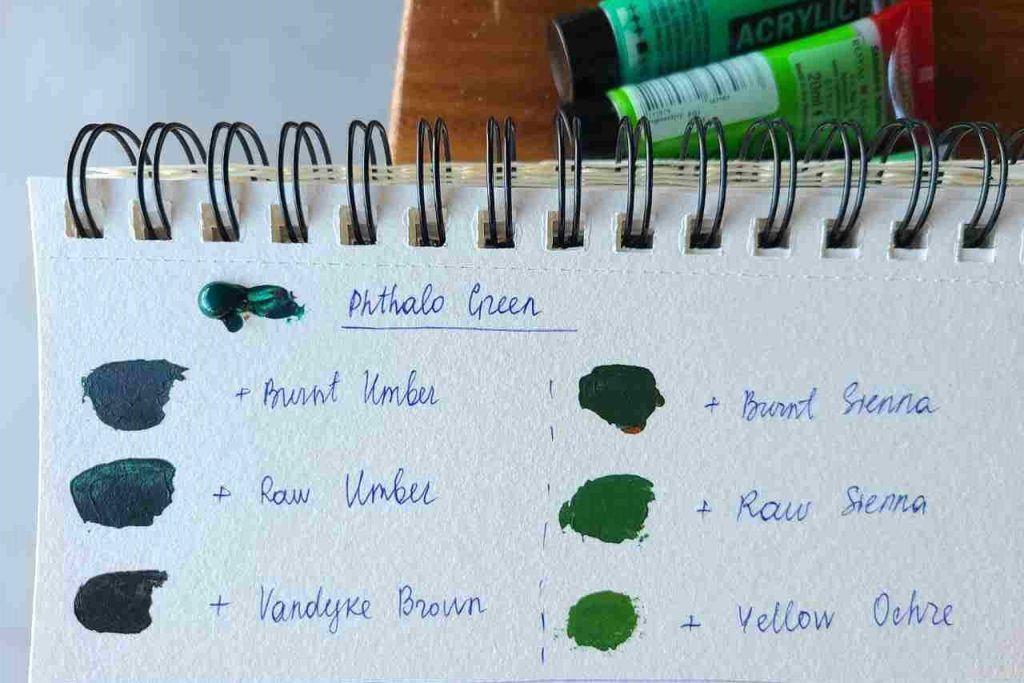
How to mix lighter shades of green?
We can add white, cadmium lemon, or more cadmium yellow to light the green.
- (Cadmium yellow + ultramarine blue) + white
- (Cadmium yellow + ultramarine blue) + cadmium lemon
- (Cadmium yellow + ultramarine blue) + cadmium yellow
How to mix darker shades of green?
To create darker green, we can use darker colors like dioxazine purple, burnt umber, and phthalo green. We will not use black because it can make the color muddy.
- (Cadmium yellow + ultramarine blue) + dioxazine purple
- (Cadmium yellow + ultramarine blue) + burnt umber
- (Cadmium yellow + ultramarine blue) + phthalo green
Learn to mix forest green color and others shades of green with this guide: Green and Brown Make What Color? Forest Green Guide
How to make the green color muted?
The key to muting a color is to blend complementary colors. Red and green complement each other; we can mix red to make muted green.
- Cadmium yellow + ultramarine blue + cadmium red
- Cadmium yellow + phthalo blue + cadmium red
- Cadmium yellow + cobalt blue + cadmium red
How to mix orange color?
Orange is a secondary color created by mixing yellow and red.
To find the perfect shade of orange, you can blend different yellows with red and other reds with yellow and create a color chart from here.
- Cadmium red + cadmium yellow is the best way to mix orange (both are warm colors)
- Cadmium red + yellow ochre
- Cadmium red + cadmium lemon
- Cadmium yellow + alizarin crimson
- Cadmium yellow + burnt sienna
- Cadmium yellow + Quinacridone Rose
- Lemon Yellow + Quinacridone Rose
- Lemon Yellow + Primary Magenta
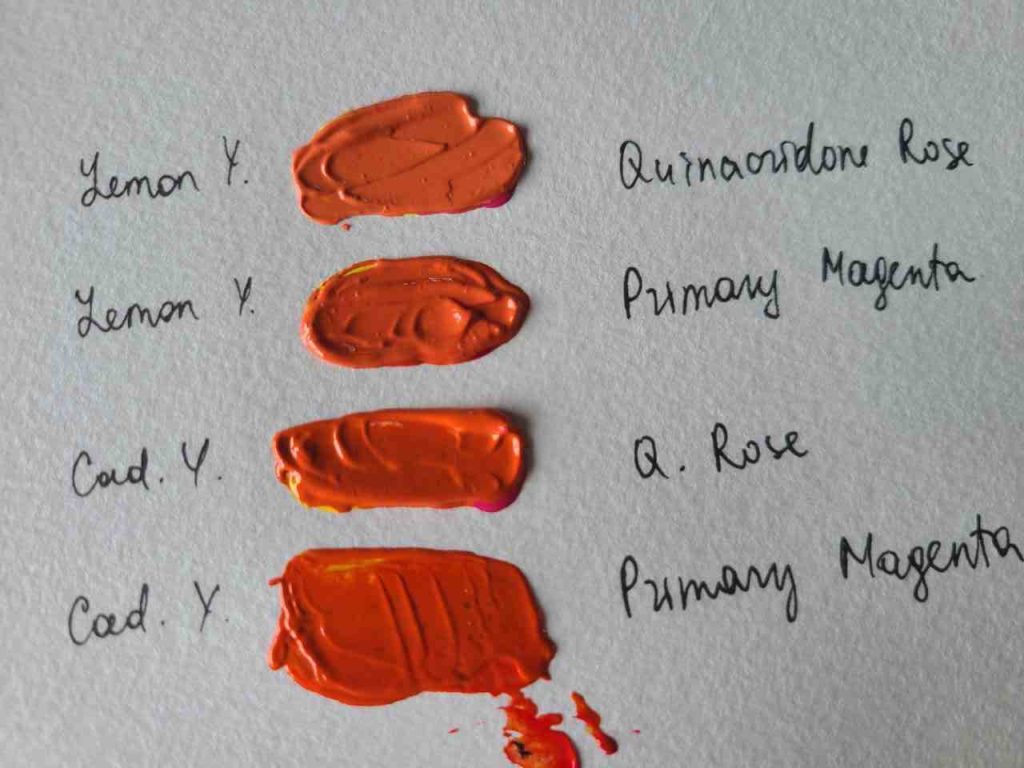
What colors make orange muted?
Orange is also a bright color; you can lessen its brightness by blending it with its complementary color, blue.
But remember to add your blue paint incrementally, as too much of it can make your mixture lean towards green and brown rather than muted orange.
If you make your mixture lean towards green, you can gradually add to it to mute the shade of green.
Read also: What Color does Orange and Blue make?
How to mix peach color?
You can use red, yellow, and white to mix peach colors. If you want a warmer shade of peach, use cadmium red and cadmium yellow. If you want a cooler hue, use lemon yellow and crimson.
Below are the steps on how you can create a peach color.
Step 1: Mix cadmium red + cadmium yellow to create orange.
Step 2: Blend your mixture with a reasonable amount of white until you lighten it and achieve your desired shade of peach.
Step 3: Adjust your shade by adding white or yellow to lighten the shade and red to darken the shade.
How to mix purple color?
We will use red and blue as bases to create purple, only that red should be dominant as purple is reddish.

It would be best to use 2 parts of red to 1 part of blue and use this ratio to blend different shades of red and blue.
Doing so allows you to create a purple color chart and see the best purple shade for your masterpiece.
Below are the shades of red and blue you can combine.
- ultramarine blue + cadmium red or magenta
- cobalt blue + cadmium red or magenta
- ultramarine blue + alizarin crimson
- cobalt blue + alizarin crimson
- green + red = dark purple
- purple or violet + yellow = muted purple
How to mix violet color?
Violet is a color mistakenly called purple frequently. Violet and purple are two different colors; violet is bluish, while the other is reddish. Having said so, we can derive that the bases of the two colors are the same, blue and red.
With violet, blue should be more dominant. You may start mixing 67% ultramarine blue and 33% cadmium red (roughly 2 parts blue to 1 part red) to create a beautiful shade of violet.
To lighten the shade, add 1 part white to your mixture or 1 part black to make it darker.
Understanding the difference between violet and purple will help you use both colors more appropriately.
How to mix white color?
White is an achromatic color, It does not have a hue or saturation.
A straightforward answer, when using acrylics, there are no two colors we can mix to create white. The only way we can make it is to desaturate the colors until nothing is left.
As we know it, white is used to lighten the shade of your colors. Others may not know that white helps the colors look more solid and opaque.
Titanium white is the best readily available white you can use because it has the market’s opaque shade of white.
Remember the rule of thumb in mixing colors, add incrementally or gradually. Too much white will make your base color a pastel color.
How to mix black color?
We can create black by blending the primary colors red, blue, and yellow. It would be best to use a dark shade for each color to make a lovely shade of black.
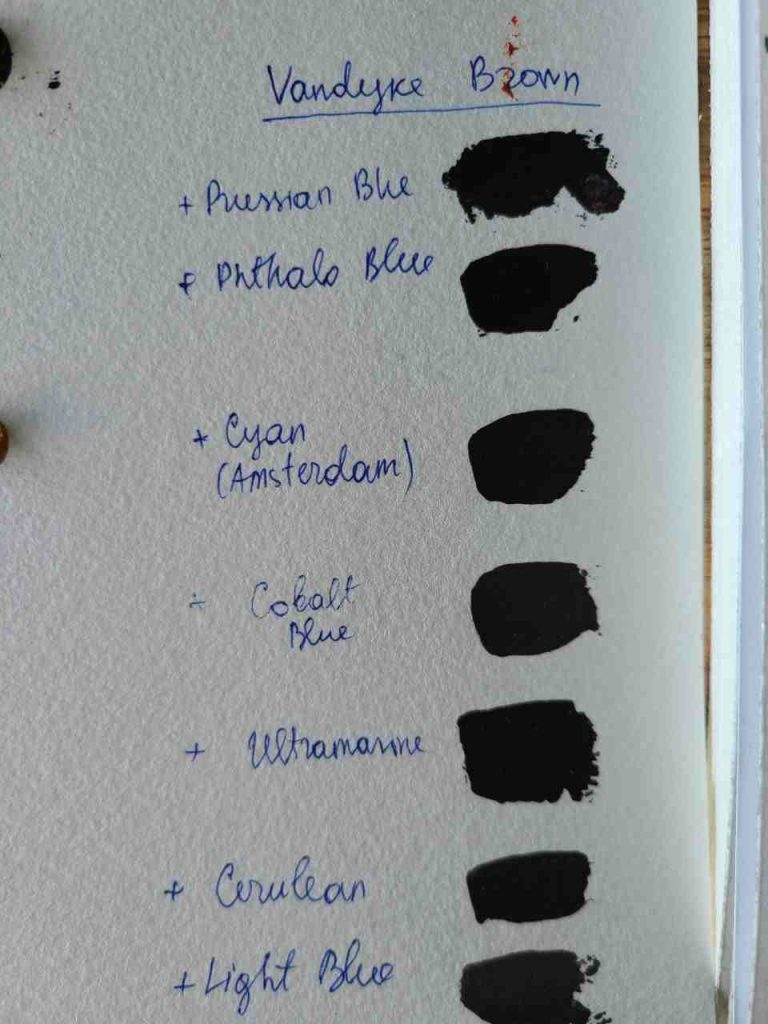
Use equal parts of:
- alizarin crimson + ultramarine blue + yellow ochre
Or equal parts of what they called “printing primaries,” the colors used for printing.
- Quinacridone magenta + phthalo blue + Hansa yellow
You can also create black using these 2 colors combination:
- Phthalo blue + cadmium orange
- Ultramarine blue + burnt umber
- Alizarin crimson + phthalo green
- Vandyke brown + blue
Black is more than what our eyes see. There’s beauty in it if you’ll get to know it more, and we’d like to help you with that! Here are How to Make Black Paint and Shades of Black. 9 Easy Tips Mixing Black
How to mix umber color?
Umber is an earth color. A natural brown earth pigment that is also known as raw umber.
Here are some umber colors available in the market:
Raw umber looks like a dull orange. To create it on your own, try one of the following ways:
- Blend orange with a bit of blue.
- Use all the primary colors (red, blue, and yellow). Blend them together.
- Add a bit of black to orange.
From there, you can adjust the shade and tone of your mixture until you achieve your desired raw umber.
How to mix pink color?
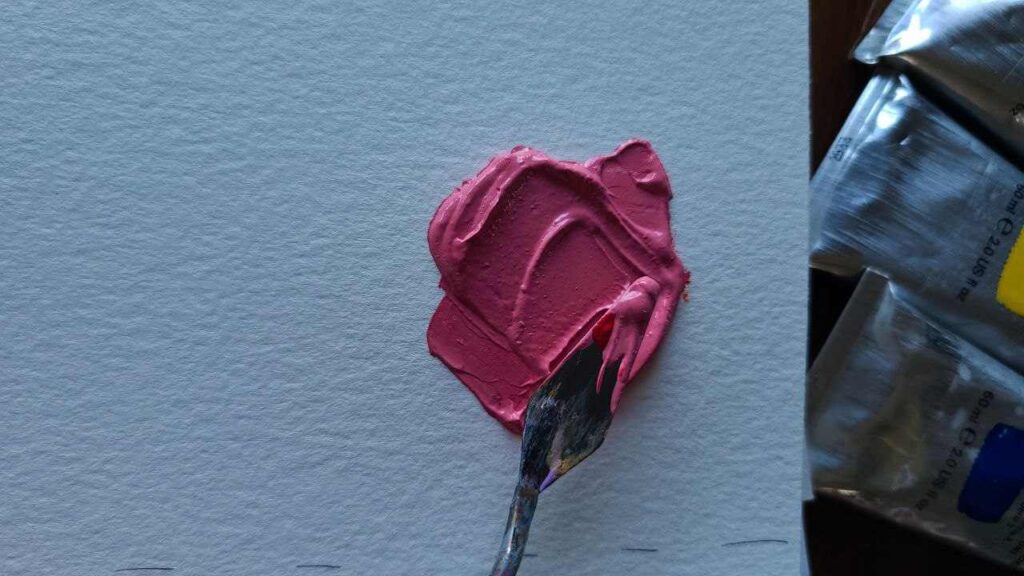
Pink is a beautiful color created by blending equal (1:1) parts of red and white. It has different shades.
- Light pink
- Hot pink
- Dark pink
- Pastel pink
To create pink color, try these combinations:
- Cadmium red + white
- Alizarin crimson + white
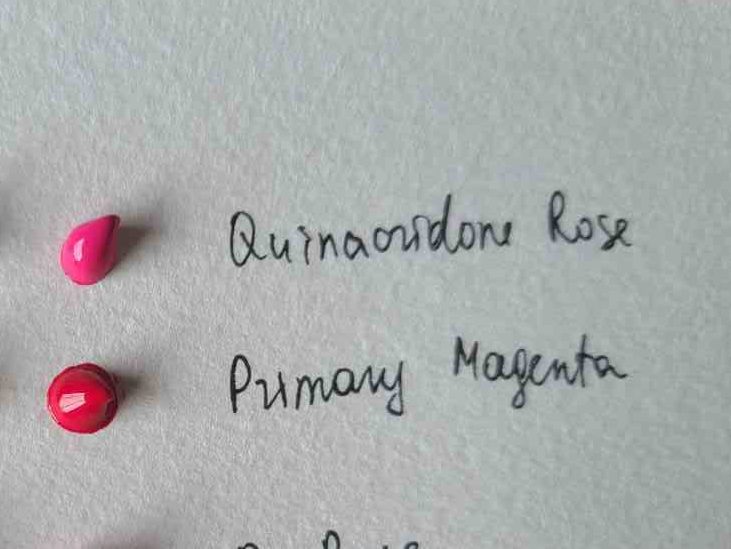
How to make different shades of pink?
Once you have in hand your pink mixture, it will be easier to play and create different shades.
If you desire a warmer shade of pink, cadmium orange and cadmium yellow could be the answer.
- (Cadmium red + white) + cadmium yellow
- (Cadmium red + white) + cadmium orange
- (Alizarin crimson + white) + cadmium yellow
- (Alizarin crimson + white) + cadmium orange
Burnt umber could be the key if you desire a darker pink shade.
- (Cadmium red + white) + burnt umber
- (Alizarin crimson + white) + burnt umber
Read also:
How to mix beige color?
Beige is a neutral or minimalist color, often light or pale brown.
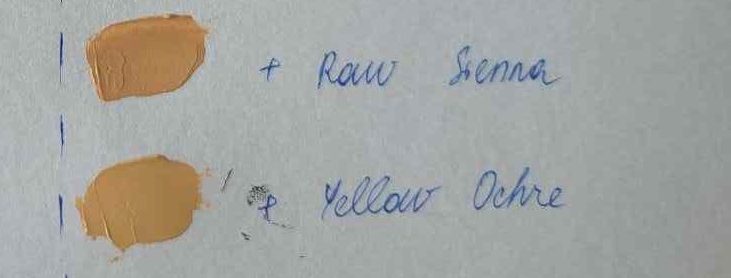
Full guide on mixing beige color testing different colors: How to Make Beige? Interesting Ideas
Mixing white acrylic paint with brown is the most convenient way to create beige. You can also blend pure white with lemon yellow.
Remember to use white as your base color and gradually add your second color until you achieve your desired shade.
If you want to create a beige color chart, it would be best to use the primary colors (red, blue, and yellow) mixed together, add white to lighten the color, and a bit of brown to adjust.
You should also dive into this article solely focused on beige!
How to mix skin tones?

Skin tones sound intimidating to mix, but it’s one of the most exciting color mash-ups.
The best way to create skin tone is to use brown by mixing all the primary colors (red, blue, and yellow). From there, we will create a color chart by adjusting the shade.
Here are tips on how you can adjust the skin tones mixtures:
- If you prefer a darker shade, you can add blue paint gradually into your mixture.
- To make the shades lighter, gradually add white or yellow until you achieve your desired color.
- To create reddish undertones or blush, use red, magenta or pink.
Here are different color combinations you can use to create 50 shades of skin tones:
- 2 parts burnt sienna + 1 part yellow ochre
- 2 parts yellow ochre + 1 part burnt sienna
- 2 parts yellow + 1 part red
- burnt sienna + a little bit of blue
- burnt umber + red
Gradually add white paint to each mixture to see different shades.
How to mix gray color?
Gray is a color created by mixing black and white. If you want your gray to be lighter in the shade, you will need to add a little more white. If you want a darker shade of gray, add a bit of blue to your mixture.

How to mix silver color?
You can mix silver using gray acrylic paint, a dash of blue, and an iridescent or pearlescent medium to make it look shiny or metallic.
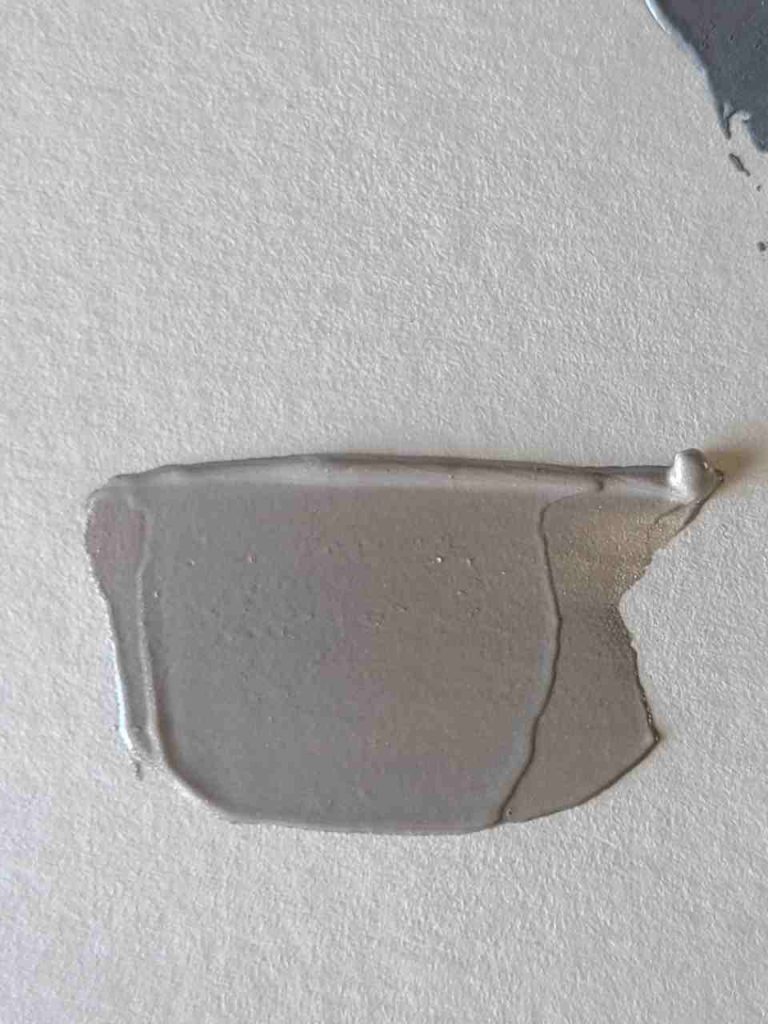
Another way is to create your gray by blending black and white and adding an iridescent or pearlescent medium to make it look shiny or metallic.
If you want to know more about silver, hop into this article solely focused on how to make silver.
How to mix golden color?
Gold is a warm metallic color. Like silver, it is possible to mix gold by blending colors.
The first method would answer the question: what two colors make gold? The two colors to create an essential shade of gold are yellow and brown.
- School bus yellow + ochre brown
Equal (1:1) parts yellow and brown could give you a nice gold color. If you aim for a more vibrant shade of gold, add a bit more yellow. If you want a muted or darker shade, add more brown.
Another method would be using all the primary colors to create brown (as the base) and then adding yellow to the mixture.
- (Cadmium red + cobalt blue + school bus yellow) + school bus yellow
You may use iridescent or pearlescent mediums to add a shiny or metallic effect.
How to mix magenta?
To create magenta, you can mix cadmium red and cobalt blue. You just have to be careful because too much blue could make your mixture violet instead of magenta, and too much red can turn it into purple.
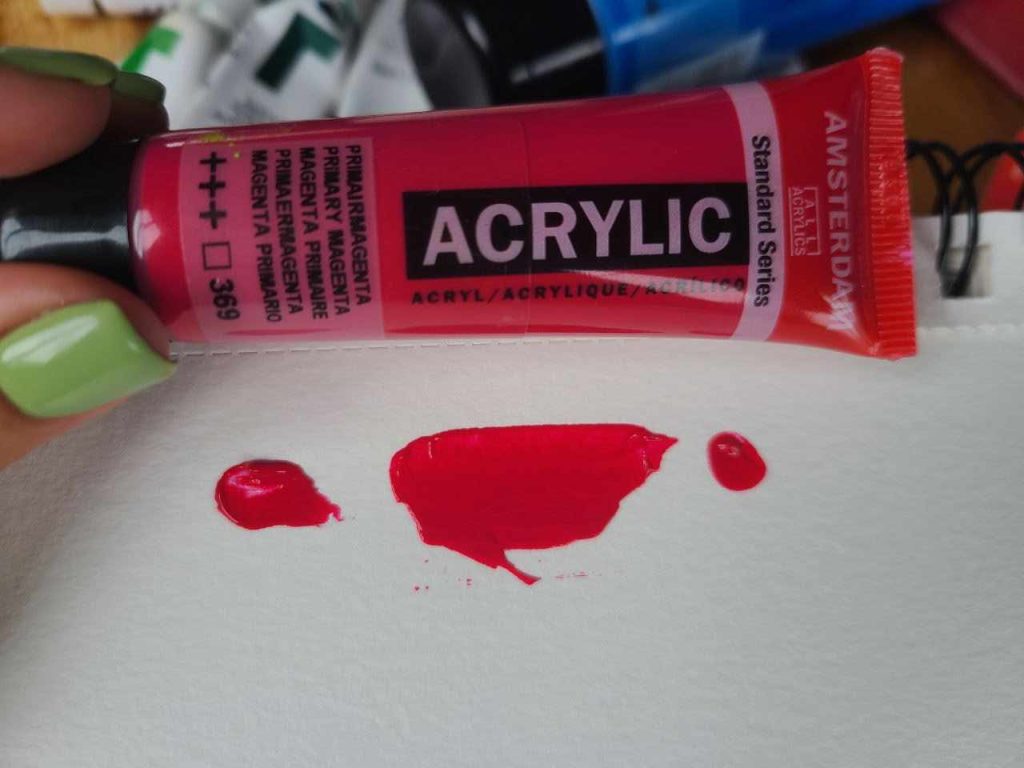
Mixing maroon and white can give you magenta as well.
I’m showing it step by step in this guide: How to Make Magenta? My 2 Personal Methods
How do you mix acrylic pour paint?
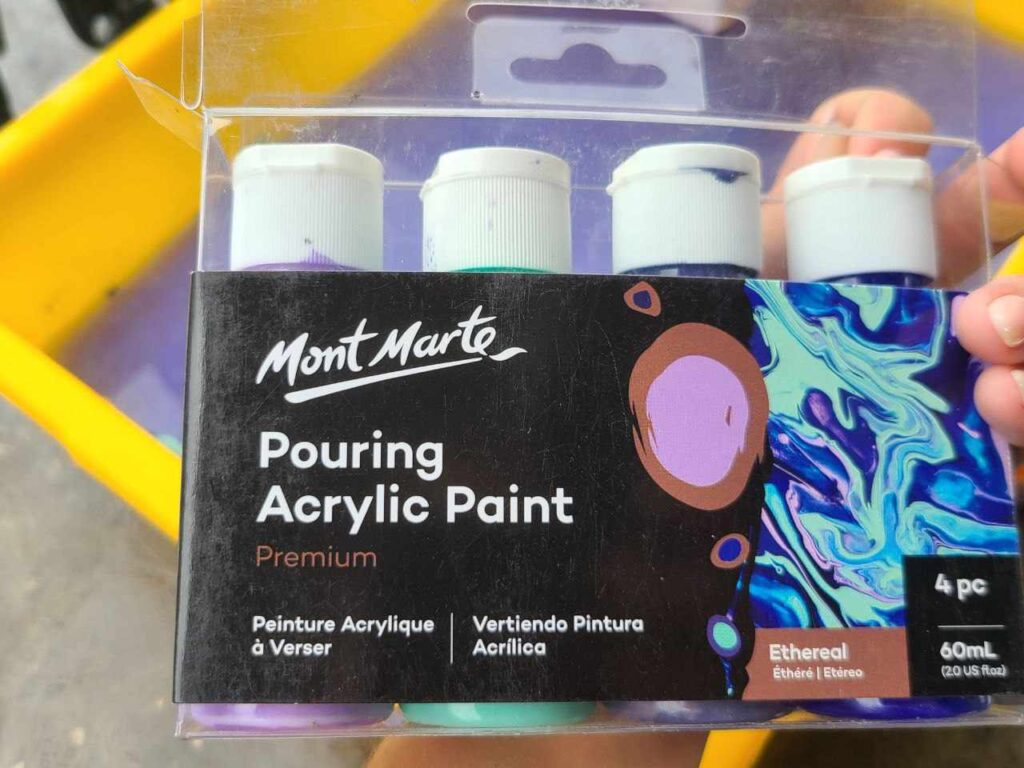
Acrylic pouring is a technique where the artists pour their paints directly into the canvas and tilt them to cover other areas without color.
You will need to liquefy acrylic paints using pouring medium, Floetrol or its substitutes, or special fluid acrylic paints which are great and ready for pouring. Some artists just thin acrylic paint with water for pouring, but I do not recommend it as it gives unpredictable results!
Here’s how to mix acrylic paints for pouring:
- Prepare cups or containers to mix acrylic paint and pouring medium.
- Put some acrylic paint in the container of your choice. I suggest squeeze bottles if you are remixing many colors upfront and then will use them within a week.
- Add in a pouring medium (equal to or twice the acrylic paint, it truly depends on brand, follow the instructions.)
- Combine the ingredients until achieving honey-liquid consistency.
- Add more water (not over 30%) if the mixture is not thin enough.
- Add a drop or two of the silicone oil and mix them well only if you want to have cells
- Let it rest, and let the bubbles rise to the surface of the acrylic mixture.
- Start pouring!
Aside from using pouring mediums, you can also use premixed paint.
How to mix acrylic paint with water?
Here’s how you can mix acrylic paint with water:
Step 1: Put a small portion of color into your palette.
Step 2: Add a drop or two of water to your color and mix them with a brush.
Step 3: If you still need to reach your desired consistency, continue dropping water into it.
Step 4: Once you are satisfied with the consistency, you can start painting.
Mixing water with acrylic paint depends on your need; for example, if you will be painting a wall, you should add more water to it so it can be spread easily. So, continue exploring and experimenting.
Adding too much water is dangerous for paint consistency and durability, please learn alternative ways to properly thin acrylic paint.
How to mix acrylic paint for airbrush?
Here’s how you can mix acrylic paint for an airbrush:
Step 1: Prepare all the materials needed.
- Acrylic paint
- Thinner or reducer
- Mixing cups
- Mixing stick
- (optional) Strainer
Step 2: Thin your acrylic paint with water (1:1) into your mixing cup.
Step 3: Stir and mix them well.
Step 4: Strain your mixture,
Step 5: Try out your mixture; once you are satisfied, begin using the mixture in your project.
How to mix acrylic paint with mediums?
You can use various mixing mediums for acrylic paint to add texture, consistency, or finish to your artwork.
There are three categories of acrylic medium, fluid, paste, or gel type. And to mix them well with acrylic paint, let’s get familiar with two kinds of mediums.
- Gel Mediums– are acrylic paint mediums that have a thick consistency. Here are the types of gel mediums:
- Glossy Mediums: Are used to achieve a shiny finished painting.
- Matte Mediums: Are used to achieve a duller finished painting.
- Modeling Gel: Is used for heavily textured paintings.
- Paste Mediums: (Modeling Paste) These are thick substances with hard solids that cause an artwork to have a solid textured effect.
- Fluid Mediums-increase the fluidity of acrylic paints. Fluid mediums are used to improve the flow of acrylic paints without compromising saturation loss.
- Here are the types of fluid mediums:
- Glazing Mediums: Are used to have a translucent effect on your painting.
- Slow Drying Medium: Is used when you need to buy time or prolong the drying time of your acrylic paint.
How to blend acrylic paint smoothly?
The key to smoothly blending acrylic paint is to achieve the right consistency, not too thick or too flowy. A right brush would be best to achieve a smooth gradient.
10 Tips on how to mix acrylic paint perfectly for beginners
- Add a lighter version of the color you are using, or add white paint to add complexity.
- To make the color more opaque, add some white paint.
- Do not use black acrylic paint to darken colors.
- When making a skin tone, use primary colors to create your base.
- Add a bit of blue, red, or green to skin tones to make it more realistic.
- Create brown paint using primary colors.
- Create your version of colors and refine it once mixed.
- Make your mixture a shade or two lighter.
- Create your own color chart.
- Used color wheel when mixing colors.
Color Mixing Chart
Get your own pdf printable and create mixing charts for paint brands you use often.
Simple instructions on how to color this mixing chart and my own chart photos are in this short article: FREE Acrylic Color Mixing Chart PDF (Works For Gouache, Oils, and Watercolor)
FAQ
What to mix with acrylic paint for fabric?
If you are using acrylic paint, it would be easy to use it on fabric. You can add fabric medium to your acrylic paint.
Here are some benefits of using fabric medium:
- Fabric medium can improve the flow of your acrylic paint when used in fabrics.
- Fabric medium will help to control the bleeding of colors when your acrylic paints are thinned with water.
- Fabric medium can add a watercolor effect, giving the artist various colors and painting styles.
Try it now and paint on the fabric using your acrylic paints!
What to mix with acrylic paint for texture?
You can use modeling gel or pastes to add texture to your painting or artwork. These acrylic paint mediums will improve the tactile quality of your paintings and artworks.
You can add acrylic mediums to the parts of the painting you want to highlight or make it look more realistic.
Can you mix acrylic paint with epoxy resin?
Yes, you can mix acrylic paint with epoxy resin. Acrylic paint is one of the most common colorants in epoxy resin projects. You can use a 1:10 ratio (1 part of acrylic paint to 10 parts epoxy resin).
The ratio of 1:10 will ensure that the resin will dry hard enough with the effective use of acrylic paint to color the resin.
Can you mix acrylic paint with polymer clay?
Yes, you can mix polymer clay with acrylic paint. Acrylic paint is the best colorant for polymer clays, whether it is acrylic paint from a tube or bottle.
Tips: paint the polymer clay with acrylic before you bake it. If you opt to paint it after you bake, you might need to sand or seal the painted surface to ensure it is protected.
Can you mix acrylic paint with gouache?
Yes, you can mix acrylic paints with gouache. It can be called acryl gouache.
Since both acrylic and gouache are water-based, it would be easy to mix them together on your palette without needing to add water.
The result of using acrylic with gouache can be characterized as a matte finish.
Read also: Gouache Vs Acrylic: What’s the Difference, and Which is Best for Beginners?
Can you mix acrylic paint and baking soda?
Yes, you can mix acrylic paint and baking soda. It will give a lovely matte finish to your painting.
It is often used when painting jars, pots, vases, ordinary bottles, or glasses.
What medium do you mix with acrylic paint?
Choosing a medium to add to your acrylic paint depends on what artwork you are doing and how you want to finish your artwork.
For example, if you use your acrylic paint on fabric, you’ll have to use fabric medium. If you need a textured finish, use gel or paste acrylic mediums.
Can you mix acrylic paint with nail polish?
No, you can’t. Mixing acrylic paint and nail polish is not recommended because they have different chemical compositions.
Summary
Acrylic paints are one of the most accessible painting mediums nowadays that can be used by anyone, from beginners to experts. Learning how to mix acrylic paints is a huge help for every artist and aspiring artist.
Learning how to mix acrylic paint saves us time, money, and probably from trouble. It’s intimidating at first, but it is enjoyable. It also enhances our creativity and gives us more freedom to play with colors.
I hope you learn so much like I did reading this article and engage yourself in topics relevant to how to mix acrylic paints. Looking forward to being with you on our next adventure!

Masha Eretnova, born in 1991, is a Buenos Aires-based certified teacher, artist, and member of the Professional Artist Association with 20+ years of personal painting journey.
She started painting and drawing very early and is now an international abstract artist and educator passionate about acrylic painting, gouache, and crafts.
Her works are part of international exhibitions and contests, including ArtlyMix (Brazil), Al-Tiba 9 (Spain), Exhibizone (Canada), Italy, and many more.
Besides her artistic pursuits, Masha holds a post-grad diploma in Teaching Film Photography and 2 music school diplomas: piano and opera singing.
